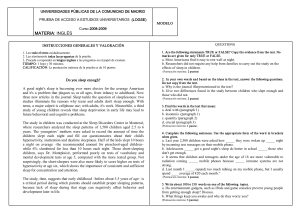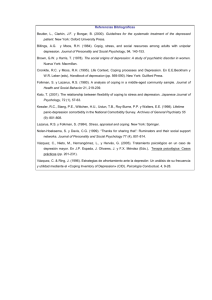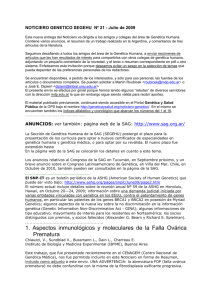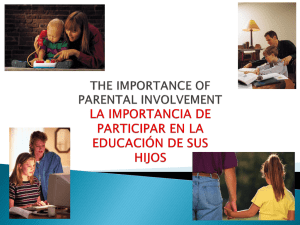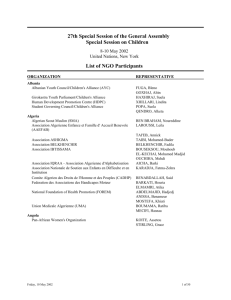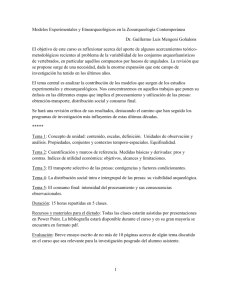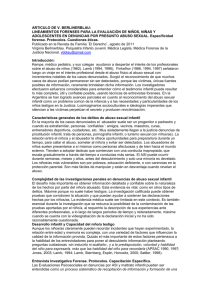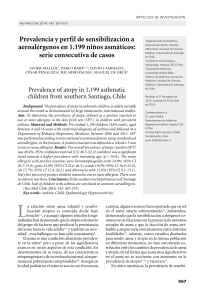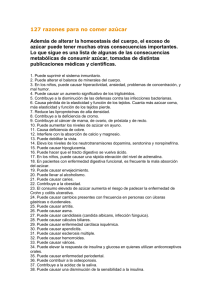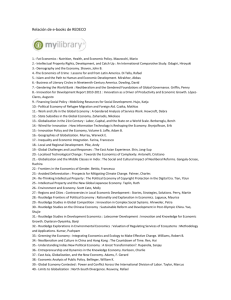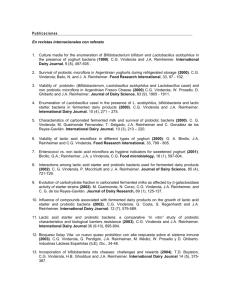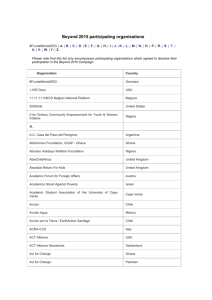Referencias
advertisement
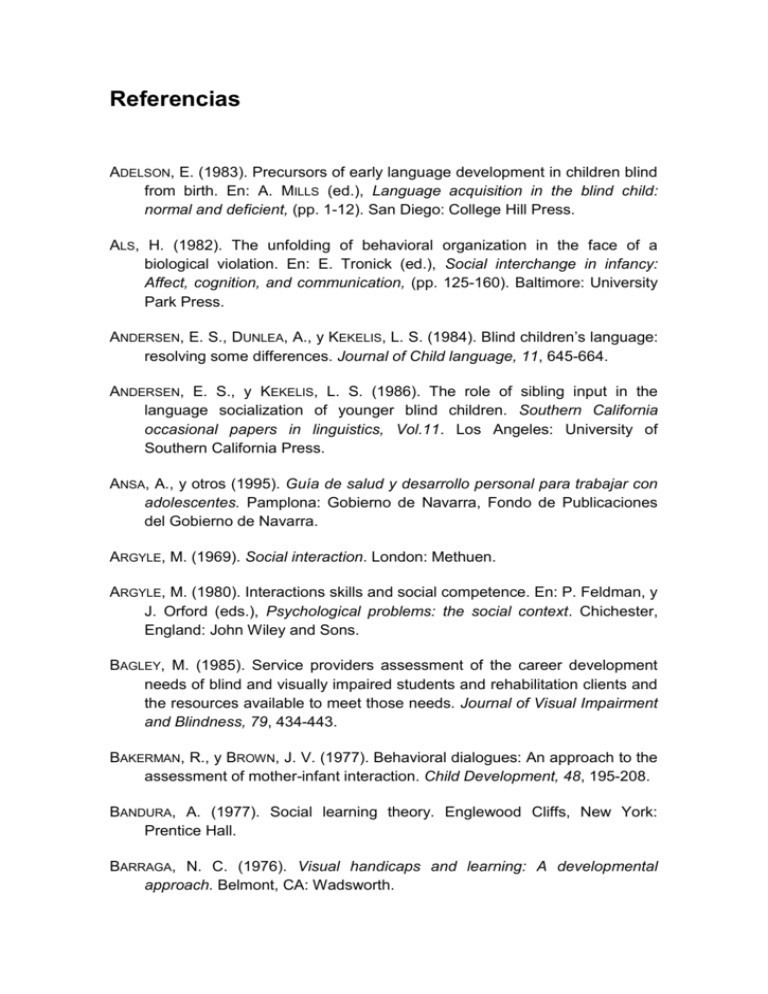
Referencias ADELSON, E. (1983). Precursors of early language development in children blind from birth. En: A. MILLS (ed.), Language acquisition in the blind child: normal and deficient, (pp. 1-12). San Diego: College Hill Press. ALS, H. (1982). The unfolding of behavioral organization in the face of a biological violation. En: E. Tronick (ed.), Social interchange in infancy: Affect, cognition, and communication, (pp. 125-160). Baltimore: University Park Press. ANDERSEN, E. S., DUNLEA, A., y KEKELIS, L. S. (1984). Blind children’s language: resolving some differences. Journal of Child language, 11, 645-664. ANDERSEN, E. S., y KEKELIS, L. S. (1986). The role of sibling input in the language socialization of younger blind children. Southern California occasional papers in linguistics, Vol.11. Los Angeles: University of Southern California Press. ANSA, A., y otros (1995). Guía de salud y desarrollo personal para trabajar con adolescentes. Pamplona: Gobierno de Navarra, Fondo de Publicaciones del Gobierno de Navarra. ARGYLE, M. (1969). Social interaction. London: Methuen. ARGYLE, M. (1980). Interactions skills and social competence. En: P. Feldman, y J. Orford (eds.), Psychological problems: the social context. Chichester, England: John Wiley and Sons. BAGLEY, M. (1985). Service providers assessment of the career development needs of blind and visually impaired students and rehabilitation clients and the resources available to meet those needs. Journal of Visual Impairment and Blindness, 79, 434-443. BAKERMAN, R., y BROWN, J. V. (1977). Behavioral dialogues: An approach to the assessment of mother-infant interaction. Child Development, 48, 195-208. BANDURA, A. (1977). Social learning theory. Englewood Cliffs, New York: Prentice Hall. BARRAGA, N. C. (1976). Visual handicaps and learning: A developmental approach. Belmont, CA: Wadsworth. BEATY, L. A. (1991). The effects of visual impairment on adolescents’ selfconcept. Journal of Visual Impairment and Blindness, 85(3), 129-130. BINA, M. J. (1986). Social skills development through cooperative group learning strategies. Education of the Visually Handicapped, 18(1), 27-40. BONFANTI, B. H. (1979). Effects of training on nonverbal and verbal behaviors of cogenitally blind adults. Journal of Visual Impairment and Blindness, 73, 19. BROWN, C., y BOUR, B. (1986). A resource manual for the development and evaluation of special programs for exceptional studentes. Vol VK: Movement analysis and curriculum for visually impaired preschoolers. Tallahassee, FL: Bureau of Education for the Blind. BUCK, R. (1991). Temperament, social skills, and the communication of emotion: A developmental-interactionist view. En: D. G. Gilbert, y J. J. Connolly (comps.), Personality, social skills and psychopathology. New York: Plenum Press. CABALLO, V. E. (1993). Manual de evaluación y entrenamiento de las habilidades sociales. Madrid: Siglo XXI. CENTERS, L., y CENTERS, R. (1963). Peer group attitudes toward the amputee child. Journal of Social Psychology, 61, 127-132. CORN, A., y BISHOP, V. (1984). Acquisition of practical knowledge by blind and visually impaired students in grades 8-12. Journal of Visual Impairment and Blindness, 78, 352-356. CORSARO, W. A. (1985). Friendship and peer culture in the early years. Norwood, NJ: Ablex. COWEN, E. L., PEDERSON, A., BABIGIAN, H., IZZO, L. D., y TROST, M. A. (1973). Long-term follow-up of early detected vulnerable children. Journal of Consulting and Clinical Psychology, 41, 438-445. CUTSFORTH, T. D. (1951). The blind in school and society. New York: American Foundation for the Blind. DION, K. K., y BERSCHEID, E. (1974). Physical attractiveness and peer acceptance among chidren. Sociometry, 37, 1-12. DURKHEIM, E. (1973). Moral education: A study in the theory and application of the sociology of education. New York: Free Press. EAGLESTEIN, A. S. (1975). The social acceptance of blind high school students in an integrated school. New Outlook for the Blind, 69, 447-451. ENDRESS, D. T. (1968). Development levels and parental attitudes of preschool blind children in Colorado. Tesis Doctoral no publicada, Colorado State College. ERIN, J. N. (1990). Language samples from visually impaired four and five year olds. Journal of Childhood Communication Disorders, 13, 181-191. ERWING, E. J. (1993). Social participation of young children with visual impairments in specialized and integrted environments. Journal of Visual Impairment and Blindness, 87, 138-142. EVERHART, G., LUZADER, M., y TULLOS, S. (1980). Assertive skills training for the blind. Journal of Visual Impairment and Blindness, 74, 62-65. FARKAS, G. M., SHERICK, R. B., MATSON, J. L., y LOEBIG, M. (1981). Social skills training of a blind child through differencial reinforcement. Behavior Therapist, 4(2), 25-26. FARRENKOPF, C., y DAVIDSON, I. (1992). The development of perspective-taking abilities in young blind children. Re:view, 24, 1, 7-22. FEFFER, M., y GOUREVITCH, V. (1960). Cognitive aspects of role-taking in children. Journal of Personality, 28, 384-397. FEWELL, R. R., y KAMINSKI, R. (1988). Play skills development and instruction for young children with handicaps. En: S. L. ODOM, y M. B. KARNES (eds.), Early intervention for infants and children with handicaps: An empirical base, (pp. 145-158). Baltimore, MD.: Paul H. Brookes. FICHTEN, C. S., JUDD, D., TAGALAKIS, V., AMSEL, R., y ROBILLARD, K. (1991). Comunication cues used by people with and without blind and visually impairments in daily conversations and dating. Journal of Visual Impairment and Blindness., 85, 371-378. FOSTER, S., y RICHEY, W. L. (1979). Issues and aspects of social competence in children. Journal of Applied Behavior Analysis, 12, 625-638. FRAIBERG, S. (1977). Insights from the blind. New York: Basic Books. FRIEDMAN, C. T. (1986). Interaction and attachment: Determinants of individual differences in a sample of visually impaired one- and two year-old and their mothers. Unpublished doctoral dissertation, University of California, Berkeley. GOLDBERG, S. (1977). Social competence in infancy: A model of parent-infant interaction. Merril Palmer Quarterly, 23, 163-177. GOLDSTEIN, A. P., SPRAFKIN, R. P., GERSHAW , N. J., y KLEIN, P. (1989). Habilidades sociales y autocontrol en la adolescencia. Barcelona: Martínez Roca. GREENSPAN, S. (1979). Social intelligence in the retarded. En: N. ELLIS (ed.), Handbook of mental deficiency: Psychological theory and research (pp. 483-531). Hillsdale, NJ.: Lawrence Erlbaum Associates. GRESHAM, F. M. (1986). Strategies for enhancing the social outcomes of mainstreaming: A necessary ingredient of sucess. En: J. MEISEL (ed.) Mainstreaming handicapped children: Outcomes, controversies and new directions. Londres: L.E.A. GUMPEL, T. (1994): Social competence and social skills training for persons with mental retardation: An expansion of a behavioral paradigm. Education and Training in Mental Retardation and Developmental Disabilities. 29, 194201. HARRELL, R. L., y STRAUSS, F. A. (1986). Aproaches to increasing assertive behavior and communication skills in blind and visually impaired persons. Journal of Visual Impairment and Blindness, 80, 794-798. HERSEN, M., y BELLACK, A. (1977). Assessment of social skills. En: A. CIMINERO, K. CALHOUM, y H. ADAMS (eds.), Handbook for behavioral assessment. New York: John Wiley and Sons. HILL, L. W., y BLASCH, B. B. (1980). Concept development. En: R. L. WELSH, y B. B. BLASCH (eds.)., Foundations of orientation and mobiliy, pp, 265-290. New York: American Foundation for the Blind. HOBEN, M., y LINDSTROM, V. (1980). Evidence of isolation in the mainstream. Journal of Visual Impairment and Blindness, 74, 289-292. IMAMURA, S. (1965) Mother and blind child. New York: American Foundation for the Blind. JANSON, U., y MERENYI, A. C. (1992). Social play between blind and sighted preschool children. Paper presented at ICEVH Early Childhood Conference, Bangkok. JOHNSON C. L., y JOHNSON, J. A. (1991). Using short-term group counselling with visually impaired adolescents. Journal of Visual Impairment and Blindness, 85, 166-170. JONES, R. L., y CHIBA (1985). Social skills assessment and intervention. (Final report). Bethesda, MD: National Institute of Child Health and Human Development. JONES, R. L., LAVINE, K., y SHELL, J. (1972). Blind children integrated in classrooms with sighted children: A sociometric study. New Outlook for the Blind, 66, 75-80. JUNEFELT, K. (1987). Blindness and child-adjusted communication. Estocolmo: Stockholms Universitet. KAGAN, J., y MOSS, H. A. (1962). Birth to maturity: A study in Psychological development. New York: Wiley. KEKELIS, L. S. (1992). A field study of a blind preschooleer. En: S. Z. SACKS, L. S. KEKELIS, y R. J. GAILORD-ROSS (eds.), The development of social skills by blind and visually impaired students. New York: American Foundation for the Blind. KEKELIS, L. S. (1992). Peer interactions in childhood: The impact of visual impairment. En: S. Z. SACKS, L. S. KEKELIS, y R. J. GAYLORD-ROSS (eds.), The development of social skills by blind and visually impaired students. New York: American Foundation for the Blind. KEKELIS, L. S., y ANDERSEN, E. S. (1984). Family communication styles and language development. Journal of Visual Impairment and Blindness, 78, 54-65. KEKELIS, L. S., y SACKS, S. Z. (1992). The effects of visual impairment on children’s social interactions in regular education programs. En: S. Z. SACKS, L. S. KEKELIS, y R. J. GAILORD-ROSS (eds.), The development of social skills by blind and visually impaired students. New York: American Foundation for the Blind. KELLY, J. A. (1982). Social skills training: A practical guide for interventions. New York: Springer. KLEIN, B., VAN HASSELT, V. B., TREFELNER, M., SANDSTROM, D., y BRANDTSNYDER, P. (1988). The parent and toddler training project for visualy impaired and blind multihandicapped children. Journal of Visual Impairment and Blindness, 82, 59-64. KLERCK, R. E, RICHARDSON, S. A., y RONALD, L. (1974). Physical appearance cues and interpersonal attraction in children. Child Development, 45, 305310. KOHLBERG, L. (1969). Stages and sequence: The cognitive development approach to socialization. En: D. A. GOSLIN (ed.), Handbook of socialization theory and research. Chicago: Rand McNally. LAMB, M. E., y EASTERBROOKS, R. (1981). Individual differences in parental sensitivity: Origins, components, and consequences. En: M. E. LAMB, y L. R. SHERROD (eds.), Infant social cognition: Empirical and theoretical considerations, pp. 127-153, Hillsdale, NJ: Lawrence Erlbaum Associates. LIEBERMAN, A. F. (1977). Preschoolers’ competence with a peer: relations with attachment and peer experience. Child Development, 48, 1277-1287. LOUMIET, R., y LEVACK, N. (1991). Independent living. A curriculum with adaptations for students with visual impairments. Austin, Texas: Texas School for the Blind and Visually Impaired. LOWENFELD, B. (1962). Psychological foundation of special methods in teaching blind children. En: P. A. ZAHL (comp.), Blindness: Modern approaches to the unseen environment. New York: Hafner. MANGOLD, S., y MANGOLD, D. H. (1983). The adolescent visually impaired female. Journal of Visual Impairment and Blindness, 77(6), 250-255. MARKOVITS, H., y STRAYER, F. (1982). Toward an applied social ethology: A case study of social skills among blind children. En: K. H. RUBIN, y H. ROSS (eds.), Peer relationships and social skills in childhood (pp. 301-322). New York: Springer-Verlag. MATAS, L., AREND, R. A., y SROUFE, L. A. (1978). Continuity of adaptation in the second year: The relationship between quality of attchement and later competence. Child Development, 49, 5-47-556. MCALPINE, L. M., y MOORE, C. L. (1995). The development of social understanding in children with visual impairments. Journal of Visual Impairment and Blindness, 7, 349-358. MCCUSPIE, P. A. (1992). The social acceptance and interaction of visually impaired children in integrated settings. En: S. Z. SACKS, L. S. KEKELIS, y R. J. GAYLORD-ROSS (eds.), The development of social skills by blind and visually impaired students. Exploratory studies and strategies. New York: American Foundation for the Blind. MCFALL, R. M. (1982). A review and reformulation of the concept of social skills. Behavioral Assessment, 4, 1-33. MCFARLAND, D. (1966). Social isolation of the blind: An underrated aspect of disability and dependency. New Outlook for the Blind, 60, 318-319. MCGUINNESS, R. M. (1970). A descriptive study of blind children educated in the itinerant teacher resource room, and special school settings. Research Bulletin of the American Foundation for the Blind, 20, 1-56. MICHELSON, L., SUGAI, D. P., W OOD, R. P., y KAZDIN, A. E. (1987). Las habilidades sociales en la infancia. Barcelona: Martínez Roca. MICHELSON, L., y W OOD, R. (1982). Behavioral assessment and training of children social skills. En: M. HERSEN, R. M. EISLEER, y P. M. MILLER (eds.), Progress in behavior modification, 14, 241-292. New York: Academic Press. MINTER, M. E., HOBSON, R. P., y PRING, L. (1991). Recognition of vocally expressed emotion by congenitally blind children. Journal of Visual Impairment and Blindness, 85, 411-416. MISCHEL, W. (1966). A social-learning view of sex differences in behavior. En: E. E. MACCOBY (ed.), The development of sex differences. Palo Alto, CA: Stanford University Press. MONJAS, I. (1992). La competencia social en la edad escolar. Diseño, aplicación y validación del Programa de Habilidades de Interacción Social. Tesis Doctoral. Universidad de Salamanca. MONJAS, I. (1996). Programa de enseñanza de habilidades sociales para niños y niñas en edad escolar. Madrid: CEPE. MORRISON, R. L., y BELLACK, A. S. (1981). The role of social perception in social skills. Behavior Therapy, 12, 69-79. O’DONNELL, L. M., y LIVINGSTON, R. L. (1991). Active exploration of the environment by young children with low vision. A review of the literature. Journal of Visual Impairment and Blindness, 85, 287-290. OCHAITA, E., y ESPINOSA, A. (1995). Desarrollo y educación de los niños ciegos y deficientes visuales: áreas prioritarias de intervención. Psykhe, 4 (2). ODOM, S. L. (1983). The development of social interchanges in infancy. En: S. G. GARWOOD, y R. R. FEWELL (eds), Educating Handicapped Children. London: Aspen Publications. OLSON, M. (1981). Enhancing the exploratory behavior of visually impaired preschoolers. Journal of Visual Impairment and Blindness, 75, 375-377. PALMER, P. (1991). El ratón, el monstruo y yo. Asertividad para jóvenes. Valencia: Promolibro-Cinteco. PARSONS, S. (1986). Function of play in low vision children (Part II): Emerging patterns of behavior. Journal of Visual Impairment and Blindness, 80, 777784. PIAGET, A. (1965). The moral judgment of the child. New York: Free Press. PREISLER, G. (1991). Early patterns of interaction between infants and their sighted mothers. Child Care, Health and Development, 5, 45-52. PREISLER, G., y PALMER, C. (1989). The blind child goes to nursery school with sighted children. Child: Care, Health and Development, 2, 484-492. PUTALLAZ, M., y GOTTMAN, J. M. (1981). Social skills and group acceptance. En: S. R. ASHER, y J. M. GOTTMAN (eds.), The development of children’s friendships (pp. 116-149). New York: Cambridge University Press. RAVER, S. A. (1987). Training blind children to employ appropiate gaze direction and sitting behavior during conversation. Education and Treatment of Children, 10, 237-246. RAVER, S. A., y DRASH, P. W. (1988). Increasing social skills training for visually impaired children. Education of the Visually Handicapped., 19(4), 59-64. RAVER, S. A., y DWYER, R. C. (1986). Using a substitute activity to eliminate eye poking in a 3-year-old visually impaired child in the classroom. The Exceptional Child, 33, 65-72. REARDON, R. C., HERSEN, M., BELLACK, A. S., y FOLEY, J. M. (1979). Measuring social skill in grade school boys. Journal of Behavioral Assessment, 1, 87105. RECCHIA, S. L. (1987). Learning to play. Common concerns for the visually impaired preschool child. Los Ángeles: Blind Childrens´s Center (ERIC document reproduction). RETTIG, M. (1994). The play of young children with visual impairments: Characteristics and interventions. Journal of Visual Impariment and Blindness, 88, 410-420. RICKELMAN, B. L., y BLAYLOCK, J. N. (1983). Behaviors of sighted individuals perceived by blind persons as hindrances to self-reliance in blind persons. Journal of Visual Impairment and Blindness, 77, 8-11. ROGERS, S. J., y PUCHALSKI, C. B. (1984). Social characteristics of visually impaired infants’ play. Topics in Early Childhood Special Education, 3 (4), 52-57. ROWLAND, C. (1984). Preverbal communication of blind infants and their mothers. Journal of Visual Impairment and Blindness, 78, 297-302. RUBIN, K. H. (1990). Introduction. Human Development, 33, 221-224. (Special issue on peer relationships and social skills in childhood - An international perspective). SACKS, S. Z. (1992). The social development of visually impaired children: A theoretical perspective. En: S. Z. SACKS, L. S. KEKELIS, y R. J. GAYLORDROSS: The development of social skills by blind and visually impaired students. Exploratory studies and strategies. NY: American Foundation for the Blind. SACKS, S. Z., y REARDON, M. P. (1989). Maximizing social interaction for students with visual handicap. En: R. GAYLORD-ROSS (ed.), Integration strategies for students with handicaps. (pp. 77-104). Baltimore: Paul H. Brookes. SCHINDELE, R. (1974). The social adjustment of visually handicapped children in different educational settings. American Foundation for the Blind Research Bulletin, 28, 125-144. SCHNEEKLOTH, L. M. (1989). Play environments for visually impaired children. Journal of Visual Impairment and Blindness, 84. 433-445. SCOTT, R. A. (1969). The socialization of blind children. En: D. GOSLIN (ed.), Handbook of Socialization Theory and Research, pp.1025-1045. Chicago: Rand McNally. SHANTZ, D. W. (1986). Conflict, aggression, and peer status: An observational study. Child Development, 57, 1322-1332. SISSON, L. A., BABEO, T. J., y VAN HASSELT, V. B. (1988). Group training to increase social behaviors in young multihandicapped children. Behavior Modification, 12(4), 497-524. SKELLENGER, A. C., y HILL, E. W. (1994). Effects of a shared teacher-child play intervention on the play skills of three young children who are blind. Journal of Visual Impairment and Blindness, sept, 433-445. SKELLENGER, A. C., HILL, M. M., y HILL, E. (1992). The social functioning of children with visual impairments. En: S. L. ODOM, S. R. MCCONNELL, y M. A. MCEVOY (eds), Social competence of young children with disabilities. Baltimore: P. H. Brookes. STEWARD, J. W., VAN HASSELT, V. B., SIMON, J., y THOMPSON, W. B. (1985). The Community Adjustment Program (CAP) for visually impaired adolescents. Journal of Visual Impairment and Blindness, 72, 49-54. TROSTER, H., y BRAMBRING, M. (1992). Early social-emotional development in blind infants. Child Care, Health and Development, 18 207-227. TROWER, P. (1982). Toward a generative model of social skills: A critique and synthesis. En: J. P. CURRAN, y P. M. MONTI (eds.), Social skills training. New York: Gilford Press. URWIN, C. (1983). Dialogue and cognitive functioning in the early language development of three blind children. En: A. MILLS (ed.), Language acquisition in the blind child (pp. 142-161). San Diego: College-Hill Press. URWIN, C. (1984). Communication in infancy and the emergence of language in blind children. En: R. L. SCHEEFELBUSCH, y J. PICKARD (eds.), The acquisition of communicative competence. Baltimore: University Press. VAN HASSELT, V. B. (1983). Social adaptation in the blind. Clinical Psychology Review, (87-102), VAN HASSELT, V. B., HERSEN, M., y KAZDIN, A. E. (1985). Assessment of social skills in visually handicapped adolescents. Behavior Research and Therapy, 23(1), 53-63. VAN HASSELT, V. B., HERSEN, M., KAZDIN, A. E., SIMON, J., y MASTANTUONO, A. (1983). Training blind adolescents in social skills. Journal of Visual Impairment and Blindness, 77, 199-203. VAN HASSELT, V. B., HERSEN, M., W HITEHILL, M., y BELLACK, A. (1979). Social assessment and training for children: An evaluative review. Behavior Research and Therapy, 17, 413-417. VAUGHN, B. E., y W ATERS, E. (1981). Attention structure, sociometric status, and dominance: Interrelations, behavioral correlates, and relationships to social competence. Developmental Psychology, 17, 275-288. VERDUGO, M. A. (1989). Programas conductuales alternativos para la educación de los deficientes mentales. Programa de habilidades sociales. Madrid: Mepsa. VERDUGO, M. A., y CABALLO, C. (1996). Desarrollo de un programa de entrenamiento en habilidades sociales para alumnos con deficiencia visual integrados en colegios ordinarios. Investigación financiada por la ONCE, Convocatoria 1991. Informe final no publicado. WALKER, H. M., MCCONNELL, S., HOLMES, D., TODIS, B., WALKER, J., y GOLDEN, N. (1983). The Walker Social Skills Curriculum. The ACCEPTS Program. Texas: Pro-ed. WARREN, D. H. (1984). Blindness and early childhood development. Nueva York: American Foundation for the Blind. YOUNISS, J., y VOLPE, J. (1978). A relational analysis of children’s friendship. En W. DAMON (ed.), New directions for child development: Vol. 1. Social Cognition (pp. 1-22). San Francisco: Jossey-Bass. Volver al comienzo del capítulo / Ir al Índice
